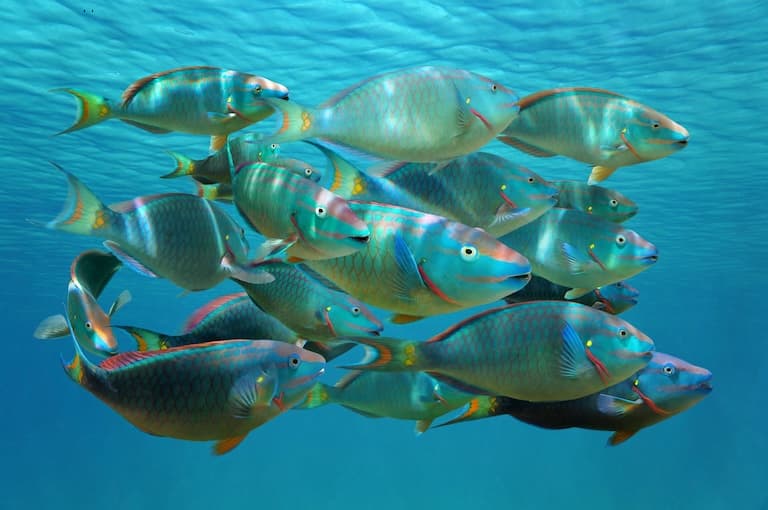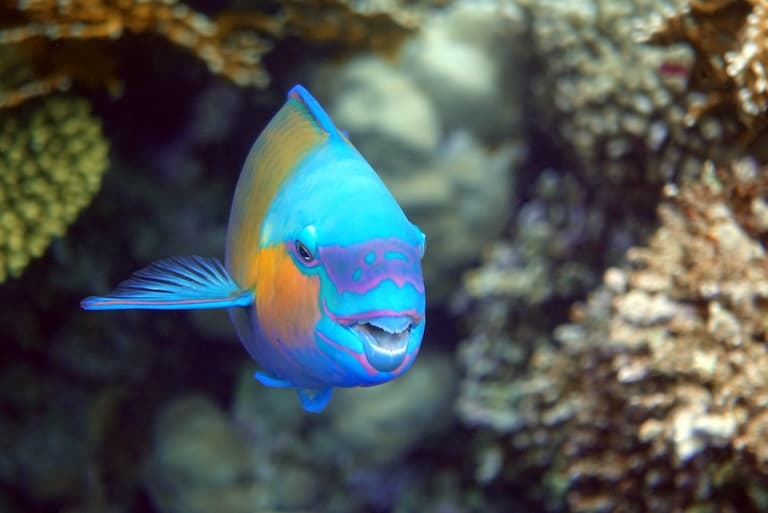Parrotfish Profile
In the tropical paradises found around the coastlines of the Indo-Pacific, you can find some of the most biodiverse and yet fragile ecosystems on Earth.
Corals represent countless generations of crustacean populations, building up a ragged foundation for algae, bacteria, shrimp, fish, molluscs and even mammals to exploit.
These corals are critically important biomes for the world’s oceans, so when you see a big, colourful fish scraping away at them with a bony beak, it might look like that’s a bad thing, but the parrotfish actually provides a very important service.

Parrotfish Facts Overview
| Habitat: | Tropical reef |
| Location: | Mostly found in the Indo-Pacific, but worldwide |
| Lifespan: | Generally 5-7 years |
| Size: | Usually less than 1.2 m (4 ft) long, smallest is 13 cm (5 in) |
| Weight: | Largest species weighs 5 kg (165 lb) |
| Colour: | Vibrant hues, changing over time, varying by species. |
| Diet: | Algae, invertebrates, bacteria, corals |
| Predators: | Sharks, eels, humans |
| Top Speed: | Slow, likely less than 10 km/h (6.7 mph) |
| No. of Species: | 95 + |
| Conservation Status: | Most are Least Concern, some Endangered (IUCN) |
Parrotfish are difficult to pinpoint, on account of their huge variety in size and colour, so their taxonomy is a bit all over the place.
One thing most have in common is what gives them their name: a huge beak on the front, often used for scraping corals.
This isn’t as bad as it sounds and keeps the reef healthy while providing awesome beaches for us to sizzle on.
Interesting Parrotfish Facts
1. They’re hard to classify
Parrotfish make up, we think, about 95 species of wrasse. It’s hard to say, for a few reasons, but one of the major ones is that they won’t stay the same colour. Colours within species change over their lifetimes, but they also vary between species, so you’ll get two parrotfish of the same species looking nothing alike.
This confusion has created a rift in the – normally so stable – fish taxonomy community, and now it’s uncertain whether parrotfish are a family, a subfamily, or just a tribe of wrasse. They are wrasse, though. Probably.
But it’s not just size and colour that complicates things, they are quite prone to changing sex, too.
There’s its sex, which they can change repeatedly throughout their lives, and their colouration and patterns, which are a classification nightmare, varying greatly, even among the males, females, and juveniles of the same species. 1

2. Most are born female
This is definitely weird, coming from an animal whose species is generally about 50/50 male to female, but it’s not so strange in fish.
In parrotfish, the majority of species are known as sequential hermaphrodites, so they don’t hold both sex organs at the same time, but they do migrate from one to the other as they age, and usually, this means they’re born female and become male later.
Some species only change sex in a portion of the population, others all do it. Only one species is known to pick a sex and stick with it: the marbled parrotfish, and the only member of its genus. Which may suggest that the sex change thing is quite a good strategy. 2
3. The first male likely has an advantage
One idea as to why this weird sex swap occurs is known as the size-advantage hypothesis, which states that a species has more reproductive success as one sex when small, and a better one as the other sex when they become large.
Parrotfish form large shoals and are usually grouped by size, which means that it’s usually a bunch of females led by a single large male. The large male can fertilise many females in one go, and his size helps him defend the harem, so both females and males benefit from high reproductive success in this configuration.
Unfortunately, this makes them bad for aquariums, as you may start with a bunch of docile female fish and end up with a whole shoal of violent rival males. 3
4. They have throat teeth
While they do fight with their beaks, that’s not the major use for them. The protrusions from a parrotfish’s mouth are distinctly bird-like and are used for scraping. These beaks wear down and are continuously replaced with new, hard material.
They use this scraping method because their food is mostly found on corals, and corals are quite rough and hard. Once they’ve scraped their morsels from the rocky substrate of the coral, they grind it even further with special teeth found in their throats.
You’d think this would upset the coral, but overall, it’s probably rather grateful for the service. 4

5. They’re mostly good for coral
This feeding method looks very destructive – and in some cases it is – but generally, the parrotfish are improving the health of the ecosystem by feeding on the algae and bacteria growing on and stifling the coral polyps.
Some species do feed directly on coral polyps, but it’s estimated that around 1% of bites are aimed at the polyps; most are scraping the algae and other small pests from it, which helps to free up more room for coral reproduction.
Even in the most corallivorous species, polyps make up around half of their diet, and it’s widely accepted that the feeding of parrotfish on the reef is a good thing.
6. They’re excavators
Again, this sounds pretty destructive, but it’s just one of the three main ways a parrotfish feeds. Excavators have the largest, strongest jaws and will be the ones most responsible for large gouges in the substrate.
But there are also scrapers, who are a bit more delicate but sometimes leave a mark.
The third feeding type is browsers, and these feed similarly to a little marine goat, plucking sea grasses and other herby things from the rocks.
All excavators begin life as scrapers and work their way up as they get stronger. Regardless of the style, the main target food groups are the microbiota that are inhabiting the substrate. 5

7. They poop beaches
All this coral munching creates a very special kind of turd. What goes in as coral gets ground up, processed and excreted as sand. One of the larger species, the humphead parrotfish, produces so much butt sand it can contribute 90kg of beautiful beach material each year.
So next time you’re lounging in the sun, listening to the waves crash gently upon the sandy beach, consider that a lot of what you’re getting stuck to your body came out the arse of a fish. 6
8. Mucous cocoon
Parrotfish are also kinda snotty animals and will avoid predation by covering themselves in a mucous sack during their downtime. We’ve all known people like this, but it’s not entirely clear why the parrotfish does it.
Some say it’s to hide their smell from predators. Maybe they just like doing it.
Parrotfish Fact-File Summary
Scientific Classification
| Kingdom: | Animalia |
| Phylum: | Chordata |
| Class: | Actinopterygii |
| Order: | Labriformes |
| Family: | Labridae or Scaridae |
| Subfamily (alternative taxon): | Scarinae |
Fact Sources & References
- Mark W. Westneat (2005), “Phylogenetic relationships and evolutionary history of the reef fish family Labridae”, Science Direct.
- J R Cardwell (1991), “Hormonal control of sex and color change in the stoplight parrotfish, Sparisoma viride”, PubMed.
- eFishkeeping (2021), “Why Parrot Fish Fighting & How To Stop It? (Explained!)”, YouTube.
- (2021), “Parrotfish Conservation”, The Nature Conservancy.
- David R. Bellwood (1994), “A phylogenetic study of the parrotfish family Scaridae (Pisces: Labroidea), with a revision of genera”, Australian Museum.
- “Parrotfish”, National Geographic.
